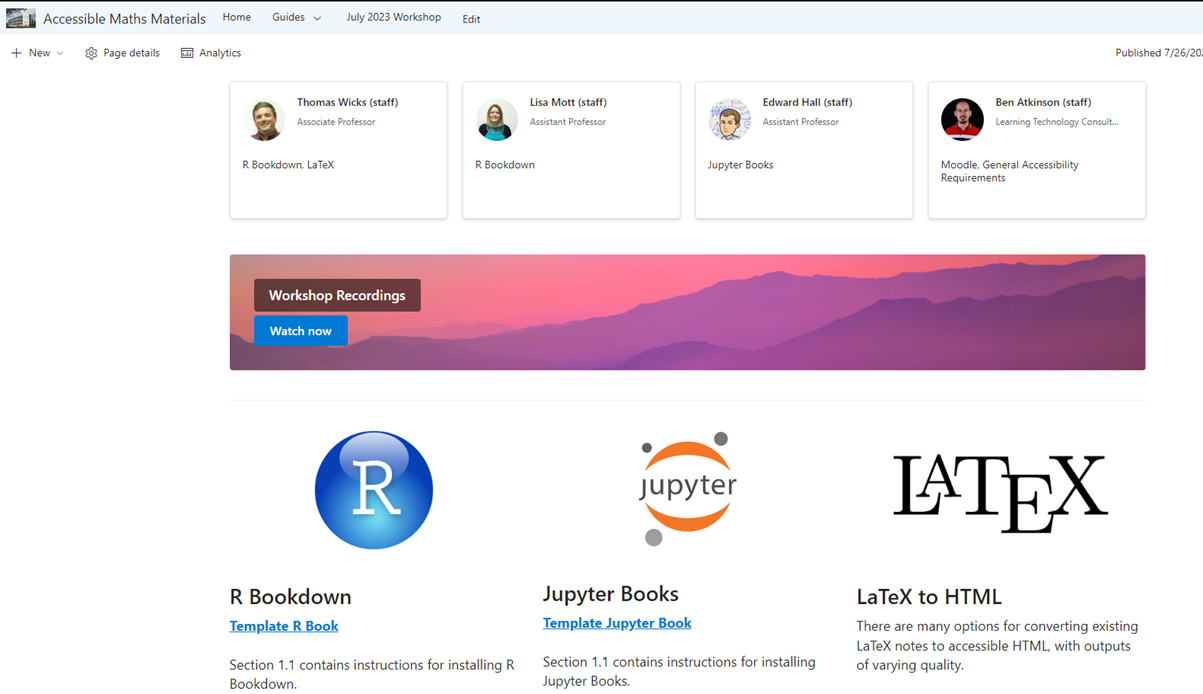
October 20, 2023, by Ben Atkinson
Faculty of Science Takeover: HTML Notebooks in Mathematics
Throughout the 2023-4 Academic Year we are running a new feature on the LT blog, a Faculty Takeover month! Each alternate month through the year we will feature posts from a different faculty at the University, with posts every Friday highlighting interesting work related to technology in teaching and learning and showcasing unique projects from within the various disciplines across UoN. Starting in October, we have our Faculty of Science Takeover.
In the post below Lisa Mott, Assistant Professor and the Digital Learning Lead for the School of Mathematical Sciences, reflects on a project to create accessible HTML notebooks to share mathematical notation with students in the new Moodle 4.1. This project was run in conjunction with Associate Professor Tom Wicks, and Senior E-learning and Digital Manager, Steve Wang.
HTML5 Notebooks in Mathematics
Pushed on by the ongoing work in the Faculty of Science (FoS) Accessibility Working Group, discussions around accessibility in the FoS Digital Learning Committee, and the introduction of a new curriculum, the School of Mathematical Sciences recently ran a workshop that aimed to help staff in the school create and maintain attractive, accessible, and interactive mathematics notes in HTML format. This approach was taken primarily because such resources would be fully accessible.
Traditionally in mathematics, notes are created as PDFs using LaTeX. This is due to a need to include complex mathematical notation, which means that it is difficult to create nice-looking notes that convey this mathematical notation to students. However, recently there has been debate about the accessibility of some PDF notes, and the extent to which they offer interactive elements to make the resources more engaging, something that can be easily achieved in HTML notes.
There was already good practice in the school with staff using R Bookdown and Jupyter Books to create interactive and accessible HTML notes and we wanted to allow staff to still have a choice between these two formats. To support this work, we created a standard template that could be applied to all HTML notebooks, and which would align with the clean layout and format of the new Moodle 4.1, meaning students felt that these notes were more embedded as part of their course.
Prior evaluations in the FoS Accessibility Working Group suggested that although current notes in R Bookdown were accessible, mathematical notation-wise, there were some colour contrast features of the standard R Bookdown template that made it somewhat not accessible; if a student needed to change the colour mode for example or access the table of contents. With the expertise and guidance of Steve Wang, the Senior E-learning and Digital Manager in the Faculty of Science, we were able to create a template that looked professional, and which ensured the colour contrast of the template and table of contents were accessible.
Once the templates were complete, it was time to share them with colleagues from across the school. We organised a workshop, during which staff were introduced to the new Moodle 4.1 and some of its accessibility features and we then demonstrated how to use the new R Bookdown and Jupyter Books templates, as well as reminding colleagues how they could create HTML notes using LaTeX (the most common way to create mathematical notes). There was an interesting discussion at the end of the workshop about creating accessible materials for students and this met our goal of providing a suite of different accessible options for creating mathematical notes.
At the end of the workshop, we published a SharePoint site (see below) where staff could access the templates, watch the workshop recordings, and find links to general advice about accessibility in the School of Mathematical Sciences. There was a great turnout from staff to the workshop and we hope that this work will benefit all our students by making notes more interactive, modern, and accessible, as well as encouraging staff to discuss accessibility in their practice and to keep up to date.
While some staff have chosen to still use PDF notes, they have made significant adjustments to their design to align it with the HTML templates we have created. In particular, the workshop raised their awareness of how to make the notes more accessible, which has strongly influenced their design choices.

No comments yet, fill out a comment to be the first

Leave a Reply